
Diamond Education
Our compact guide below helps you understand the 4 Cs of diamonds – and more – to ensure the maximum quality and value of your selection.
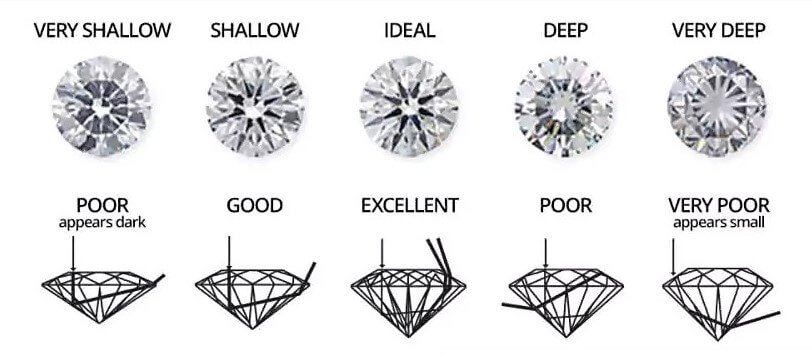
Not only do well-cut diamonds appear more brilliant, they also tend to appear larger than other diamonds of the same carat weight. An “ideal” diamond has both increased brilliance and diameter relative to more deeply-cut diamonds.
Understanding Brilliance, Dispersion & Scintillation
A well-cut diamond exhibit three different properties: brilliance, dispersion and scintillation. As light strikes a diamond’s surface, it will either reflect off the table of a polished stone or enter the diamond. The light that is reflected off the diamond is known as the diamond’s brilliance. As light travels through a stone, some of the light rays are separated into flashes of colour. This is known as dispersion. The result of dispersion – the separation of white light into its spectral colours – is known as fire. Scintillation is flashes of colour that are viewable as an observer moves a diamond back and forth.
Generally, when comparing colour between two diamonds, the diamonds need to be at least two colour grades apart to even begin to see a difference. As you can see from the images below, when diamonds are in the face up position, it is almost impossible to see any colour. When viewing the diamond from the side profile, you may start to detect some colour; however, diamonds are admired for their beauty from the face up position and not the side.

Colourless Diamonds (D-F):
Diamonds within the colourless range are the most rare and valuable of all those on the colour scale. D/E colour stones display virtually no colour, whereas F coloured diamonds will display a nearly undetected amount of colour when viewed face down by a gemmologist.

D Colour

E Colour
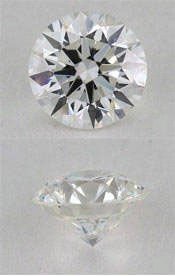
F Colour
Near Colourless Diamonds (G-J):
Diamonds within the near colourless range appear colourless in the face up position, but do display a slight amount of colour when viewed face down against a perfectly white background. This trace amount of colour will be undetectable to an untrained eye once the diamond has been mounted. Near colourless diamonds offer a tremendous value for their price.
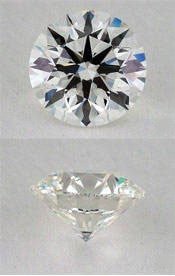
G Colour
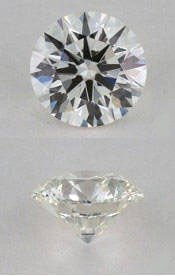
H Colour

I Colour
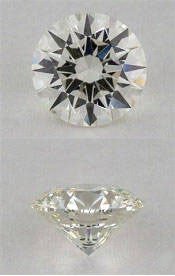
J Colour
As you can see, the colour difference between D to I is not that immediately visible to untrained eyes. However, the most obvious difference between diamonds is the carat weight. Therefore when considering purchasing a diamond with a budget, Amami can advise you to optimise your budget to get the most out of a piece of diamond.

Which Clarity Grade to Choose?
It is important to select a diamond that does not have any inclusions that will affect the overall beauty and durability of the diamond. If you want to be 100% sure that your diamond will be completely clean of “eye-visible” inclusions, stick with diamonds graded “VS2” or higher. Shopping for SI quality diamonds can be very rewarding, but it’s best to have those diamonds reviewed by us before finalizing your order. This will ensure you receive a diamond that does not have any inclusions visible to the naked eye.
It is also a good idea to balance the clarity grade of your diamond with the colour. If you are looking at diamonds in the D-F colour range, focus on clarity grades of VS2 or higher. Diamonds in the G-I colour range combined with SI clarity are excellent values.

Diamond Size and Diamond Carat Weight
The size of a diamond is proportional to its carat weight. When rough diamonds are cut and polished into finished diamonds, up to 2/3 of the total carat weight may be lost. Since larger rough gems of high quality are found less frequently than smaller rough gems of high quality, a single two carat diamond will be more expensive than two one-carat diamonds of the same quality.
A diamond will increase in weight much faster than it increases in actual “face-up” diameter. For example, while an ideal cut one-carat diamond measures approximately 6.5 mm in width, a diamond of twice its weight measures only 8.2 mm wide – less than a 30% increase.
Which Carat Weight Is Right For You?
This question has no direct answer. It is a choice that depends on personal preference and budget. When looking at a diamond engagement ring, what is most visible is the size of the surface area on the top of the diamond. It is difficult to measure a diamond’s carat weight simply by looking at it. Although carat weight influences cost quite a bit, it is advisable to focus on diamond cut and diameter.
At Amami, we honour our policy in being transparent and provide detailed accurate information to our customers with actual diamond images, videos (if available), eye clean status and the degree of brilliancy of the diamond making purchasing a hassle free experience.